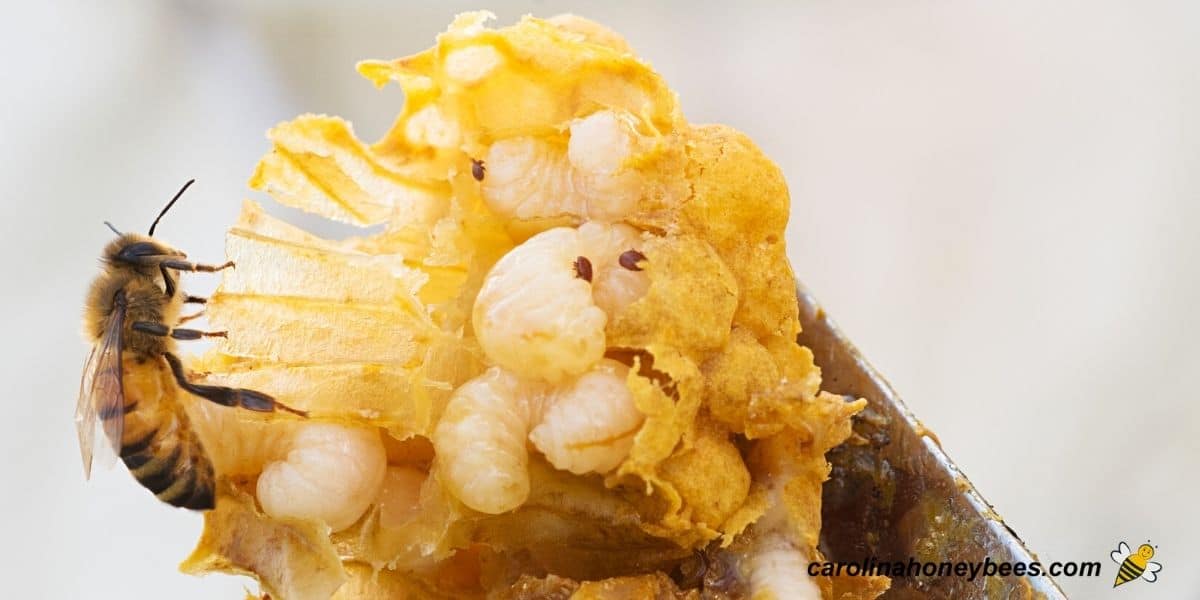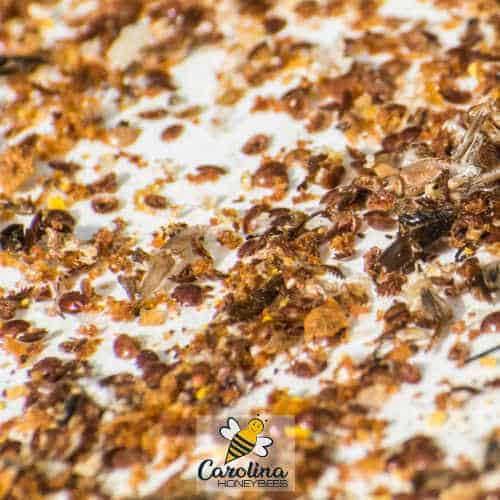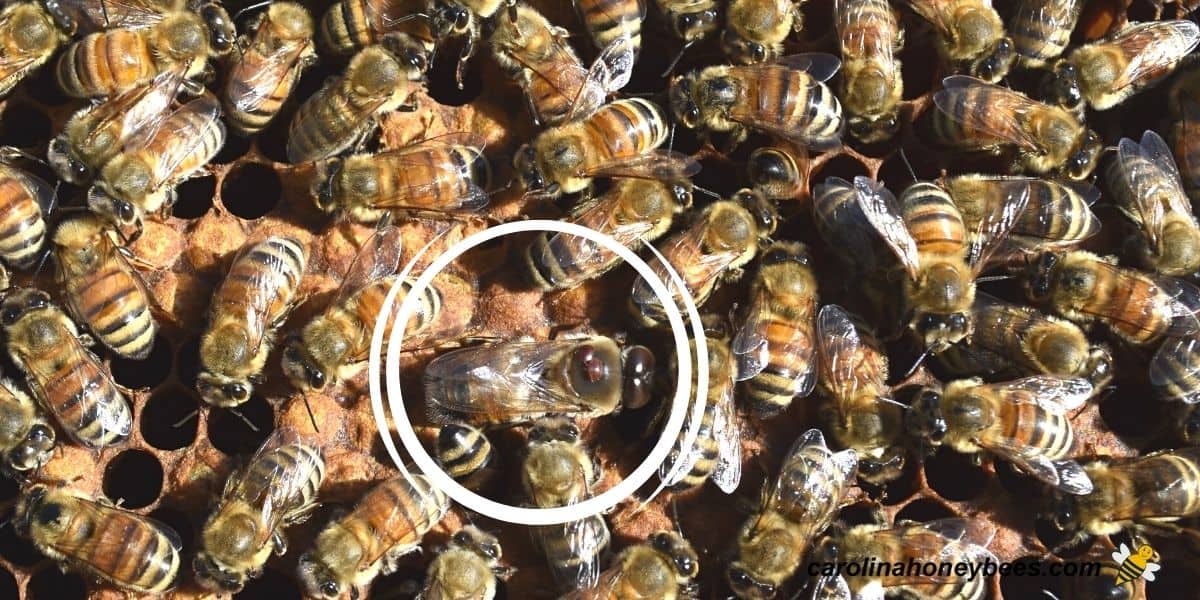When to Treat Bees For Mites?
In the world of honey bee management, deciding when to treat bees for varroa mites is one of the most important decisions. It is the job of the beekeeper to navigate the balance between being proactive in pest management vs interfering too much with colony dynamics. This article aims to be a guide for beekeepers faced with the decision of deciding when to treat or not.

The honey bees found in the United States (Apis mellifera) are of European origin – with no previous history (or resistance) to varroa mites. Once the mites arrived in force, beekeeping changed with a new focus on controlling this major pest of honey bees.
Significance of Timely Mite Management
Varroa mites feed on the fat bodies of honey bees and serve as vectors for bee viruses and disease. They weaken colonies and result in sick non productive hives.
Problems caused by high number of varroa mites are devastating-resulting in massive colony loss. Stressed colonies are more likely to suffer from problems such as European Foulbrood or Nosema disease.
Varroa Mite Treatment Thresholds
There are several approved varroa mite treatments to consider using for control. But, any treatment plan (even natural ones) causes some stress to our colonies. We want to avoid unnecessary treatments.
Also, beekeepers with a lot of hives find it expensive to treat their colonies. In the interest of saving money, work and stress for the bees, researchers have developed treatment thresholds.
These are general guidelines that a beekeeper can use to make a plan for when it is time to take action against varroa mites.
Economic Threshold
Often called the “economic threshold”, research says that when the mite infestation reaches a certain level, the colony will experience decline and be less productive. If mite growth is allowed to continue, the colony will die.
Unfortunately, these numbers are “soft” and tend to vary somewhat from one region to another. And, they vary from one expert to another and one year to another.
But, we can still use them as a guide. Just remember, acceptable mite levels are guidelines-not rules set in stone.
In my years of beekeeping, the “allowed” number for mite infestation keeps dropping. We are learning that it takes fewer mites than previously thought to harm bees.
Treatment Schedule Varies
Everyone wants a calendar to tell them exactly when to treat their beehives for mites – that’s hard to do. The exact timing of mite treatments depends on several factors: the genetics of your bees, the product used for mite control and where you live.
Some honey bees are more susceptible to mite problems and some regions of the country seem to have a bigger problem with mites.
Therefore, the beekeeper should learn how to monitor mite levels in the hive. From there, you can decide what if any action to take.

Mite Levels -Testing
Beginner beekeepers often say, can’t you see mites on adult bees? Yes, you can. But, you can not use visual inspection to judge your infestation levels.
You will not be able to see the vast majority of mites that are reproducing in the brood cells. By the time you notice mites on your adult bees it may be too late to save the colony.
The sugar shake and alcohol roll are two common methods for testing for varroa mites that any beekeeper can complete. Another, though not as accurate is the bottom board drop count.
Once you have performed your counts of the estimated mite levels, it is time to analyze your findings. Often, we are told it is time to treat if the infestation level is over 2%.
However, time of year plays a role too – it is commonly advised to treat if the infestation is over 1% in the Spring and 3% in the Fall.
Calculate Mite Percentage Using 300 Bees:
A standard ½ cup (measuring cup) of bees from frames in the brood nest yields roughly 300 bees. After conducting your sugar shake (or alcohol wash) count any varroa.
If we find 9 varroa in this number of bees, you have a 3% infestation level. (i.e. 9 mites/300 bees = 3 mites per/100 bees.) At this rate, I would definitely treat for varroa mites.
But, what if you find a 2% infestation or even 1%. Can a single mite count give true results? Some beekeepers promote multiple mite counts for accurate numbers. However, few beekeepers do multiple counts.
Should You Treat Bees for Mites With Infestation Levels Below 3%?
In regions where mites are known to be bad, treatment is almost always necessary. Finding no mites or a 1% level may encourage you to watch and wait for a bit.
Depending on the time of year you may be able to skip mite treatments for a while-but it is a risk.
If the infestation level is 2% or greater, you have a decision to make. Depending on your schedule and the time of year, the beekeeper may go ahead and implement a treatment to keep the mite population low.

Late Season Varroa Mite Bombs
Why do many beekeepers have low mite levels in July and big problems later in the season. Often, they find a dead bee hive that must be cleaned up by late Fall? These large, robust colonies seem to dwindle or disappear very quickly.
To begin to understand why this happens, we must look at the life cycle of each of the players in our game.
Bee Life Cycle
The life cycle of honey bees is not the same as that of the mites. The journey of the individual worker honey bee begins with an egg that reaches adulthood in 21 days.
The adult phase of the queen bee life cycle is reached in only 16 days. But the drones, or male honey bees, are the favorites for varroa mites. Drones emerge from their cells on day 24.
They spend 3 more days in the sealed cell. Keep in mind, the total population of the colony and the number of workers vs drones cycles throughout the year.

Life Cycle of Varroa Mites
Varroa mites also go through several stages of development. The mated female mite (foundress mite) rides around on an adult bee. She feeds on the bee by biting through the bee’s exoskeleton.
Phoretic Stage
This is called the “phoretic stage”. This stage of life lasts 5-11 days when brood is in the colony. During Winter months with no brood, the phoretic stage can last for months!
Reproductive Phase
When the foundress mite is near a bee larva (almost ready to pupate), she drops off the adult bee and enters the brood cell. Hiding under the brood food in the bottom of the cell, she is capped inside with the bee larva.
Varroa mites can only reproduce inside the brood cell. The female mite produces a male mite first and then a daughter or daughters inside the cell.
Many mite treatments only kill the phoretic mites – not the ones hidden inside brood cells. Treating for varroa mites may need to be done in phases to catch mites out of the cells.
Mite Reproduction in Worker Brood
A worker bee cell is capped for 11 days giving the varroa time to produce 1.5 females. (Yea, I know you can’t have half a mite! – It’s a science average thing.)
The new female mite mates with her brother inside the cell. They feed on the developing bee, weakening it, and possibly spreading disease.
When the new bee emerges (assuming it is able to do so), the mother mite and her mated daughter emerge as well. The male mite dies inside the cell.
So, 1 varroa mite went in and about 11 days later – 2 came out. These 2 fertile female mites enter a new brood cell and both produce a viable daughter.
The original mother will be nearing the end of her life cycle. But, we still have 3 females inside the hive that originated from the first female or “foundress mite”.
Varroa mite numbers triple each month – by reproduction in worker bee cells.

Impact of Drone Brood on Varroa Mite Population
Drone bees have a longer brood cycle – 24 days. And, varroa can identify the type of brood in a cell through bee pheromones. (They “smell” different).
On average, we can expect the mother mite and 2 viable daughters to emerge from a drone cell. This gives us 3 mated females from 1 drone brood cell (instead of 2).
These 3 mites find another drone cell. 14 days later, 8 viable mites emerge (because mom is at the end of her life cycle).
In just a little over a month (36-38 days) 1 foundress mite, became 8. Imagine how fast this reproduction can grow with hundreds of mites in hundreds of drone brood cells.
No Control – Varroa Mite Reproductive Explosion
The Varroa mite population in a colony will triple in a month when reproducing on only worker brood. But with drone brood inside, the mite population can double every 2 weeks.
Studies indicate that for every phoretic mite on a bee, there are 2-3 more mites under the brood cappings. In July, if you find 100 mites on the house bees, there are about 300 under the caps for a total of 400 mites.
If the mite numbers triple in a month, that means 400 mites (July), 1200 (August) and 2400 (September).
And that is when worker brood is used for mite reproduction not drones! Drone brood will allow even more mite reproduction.
Fall Absconds or Heavy Mite Loads?
It is not uncommon to hear of late Summer or Fall absconds. An “absconding beehive” is the term used when all the bees in the hive are gone. This differs from a swarm of bees .
Reproductive swarms leave part of the bee population behind. In absconding, none or very few bees remain in the hive.
Perhaps some of these empty Fall hives are not true absconds but colonies collapsing from large numbers of varroa mites. We don’t know exactly why this would happen other than the bees trying to leave a losing situation.

Best Time of Year to Treat Hives
While it is difficult to tell any beekeeper exactly when to treat bees for varroa mites – we can give some generalities. In most cases, an early Spring treatment may be necessary. This can be part of your Spring beekeeping chores.
This gets mite loads down before the honey flow begins. Most treatments for mite control can not be used when honey supers are on the hive – read your labels.
Monitor mite levels during the season. By mid July, many colonies have already started to slow down egg laying. Most colonies will have more older bees dying than are emerging. This results in a dropping population. (Your mite population is still tripling each month.)
As varroa mite numbers rise and bee brood numbers are reduced, a point is reached where every brood cell has a mite.
If not required before then, a late Summer mite treatment lowers the number of mites and allows the colony to raise healthy fat bees for Winter.
Don’t wait until Fall, it may be too late. It does not matter whether you use oxalic acid vaporization for bees, VarroxSan strips, formic acid or another method – do something if needed. Then, check to see that they worked!
The No Treatment Method
Many beekeepers strive to move away from the use of chemical treatments. And, the future looks promising as bee breeders work to breed mite resistant bees.
But for the vast majority of beekeepers, failure to control varroa mites in the hive will result in a mite crash. This means that the bee colony dies as a result of varroa.
The idea of not having to worry about varroa mites is great but the reality is that it doesn’t turn out well for most beekeepers. Many hives die needlessly.
FAQs
Each mite treatment method has a temperature range in which it performs best – follow the directions. From a level of infestation view, treat before the mite levels grow so high that no healthy bees are left to recover.
Use your mite counts as an indicator of colony status. Most researchers agree that a varroa infestation rate over 2- 3% needs treatment.
One common way of identifying a possible mite problem is noticing Deformed Wing Virus (DWV) in your hive. Colonies with high mite levels tend to have more problems with this virus. However, this alone is not a true indicator of the severity of the infestation.
Final Thoughts
Mite resistant bee breeding is the hope for the future. I have not found a bee that can exist treatment free in my region, but I remain hopeful. Do your mite counts and pay attention to new recommendations for when to treat for varroa. These change from time to time.
When is the right time to treat bees for varroa mites? Before, it is too late – that’s the honest truth – your hive will reach a point of no return.

